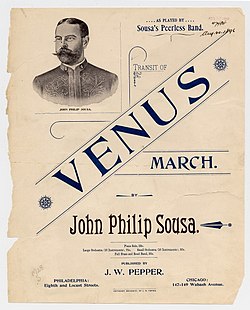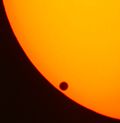| "Transit of Venus March" | |
|---|---|
| March by John Philip Sousa | |
 Sheet music cover (1896) | |
| Occasion | 1882 Transit of Venus |
| Composed | 1883 |
| Dedication | Joseph Henry |
| Publisher | J.W. Pepper Co. |
| Audio sample | |
2016 performance by the United States Marine Band | |
The "Transit of Venus March" is a march scored for military brass band written by John Philip Sousa in 1883 to celebrate the 1882 Transit of Venus and published by the J.W. Pepper Company. The work was erroneously thought to be lost for over 100 years when a piano transcription [note 1] published in 1896 was found by a Library of Congress employee in 2003. [1] Copies of the original Pepper publication, however, do survive.



